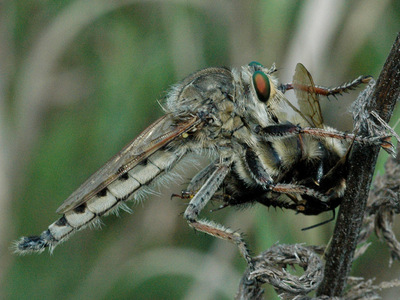
Nutrition
The larva of Promachus
vertebratus are typically cream-colored and live in the soil or
in decaying wood in which they hatch. To begin feeding, the larvae pierce the
body of their prey and suck the bodily fluids from the initial wound.
These larvae have been observed feasting on grasshopper eggs and
white grubs because these insects will generally feed on eggs or
any soft-bodied insects that they have access to (Mahr S. 2009).
According to observation, the larva of Promachus vertebratus
is the most likely of the asilids known to attack white-grubs.
Typically, the larva of Promachus vertebratus will
engage theses grubs when they have become less inactive and are
in the process of making cells for pupation (Malloch J. R. 1922).

The adult Promachus vertebratus are
predominantly aggressive, generalist hunters. Because they are
generalist hunters, they
have been documented attacking butterflies, wasps, bees,
dragonflies, grasshoppers, beetles, and other flies. Overall,
this species will take down the vast majority of flying insects
that it can get its proboscis into. Not
notoriously harmful to humans, some of the
larger species of robber flies can even inflict a painful bite if handled carelessly
(Mahr S. 2009).
This picture of an adult Promachus
vertebratus taken from
WisconsinButterflies.org, shows how this insect takes down
and digests its prey.
With the help of a short, strong proboscis,
this robber fly stabs its victim, injecting saliva usually
containing neurotoxic enzymes (look at the picture above!). The robber fly can then suck its
captured meal through a straw, as these enzymes paralyze and
digest the insides of the prey.
Return to home page Back to adaptation page To reproduction page